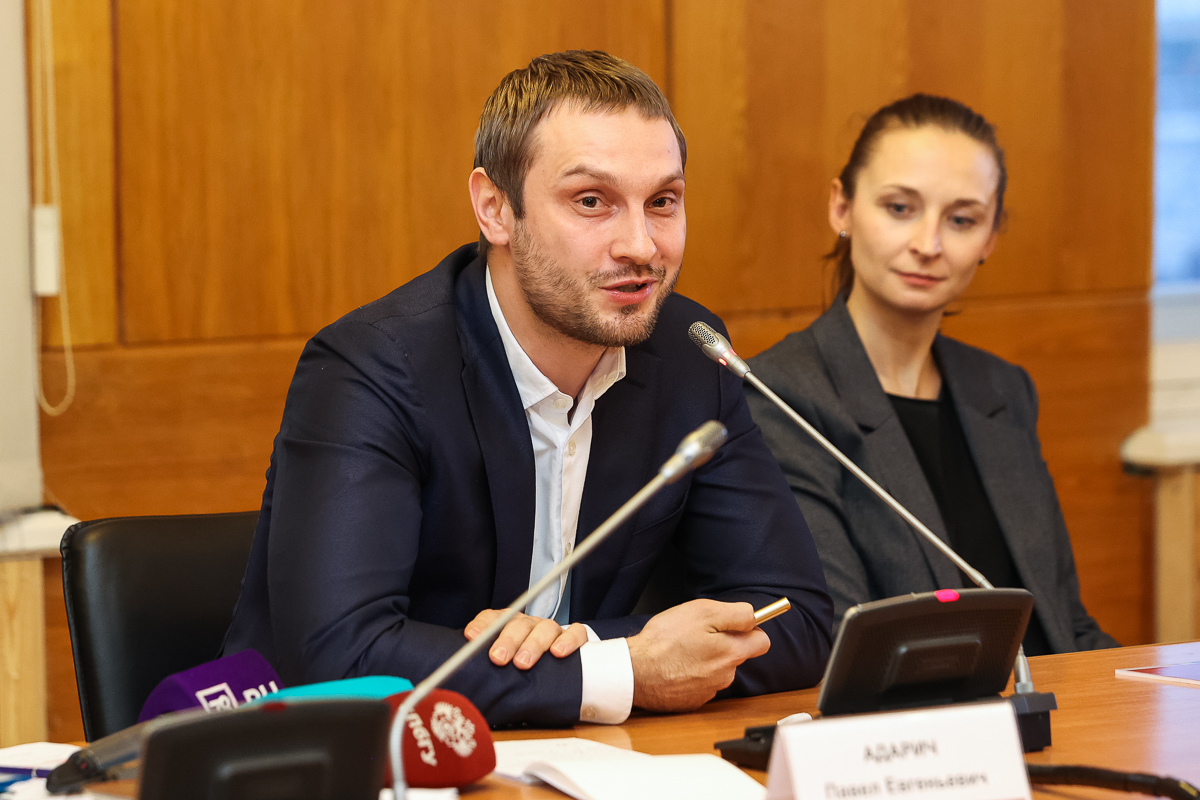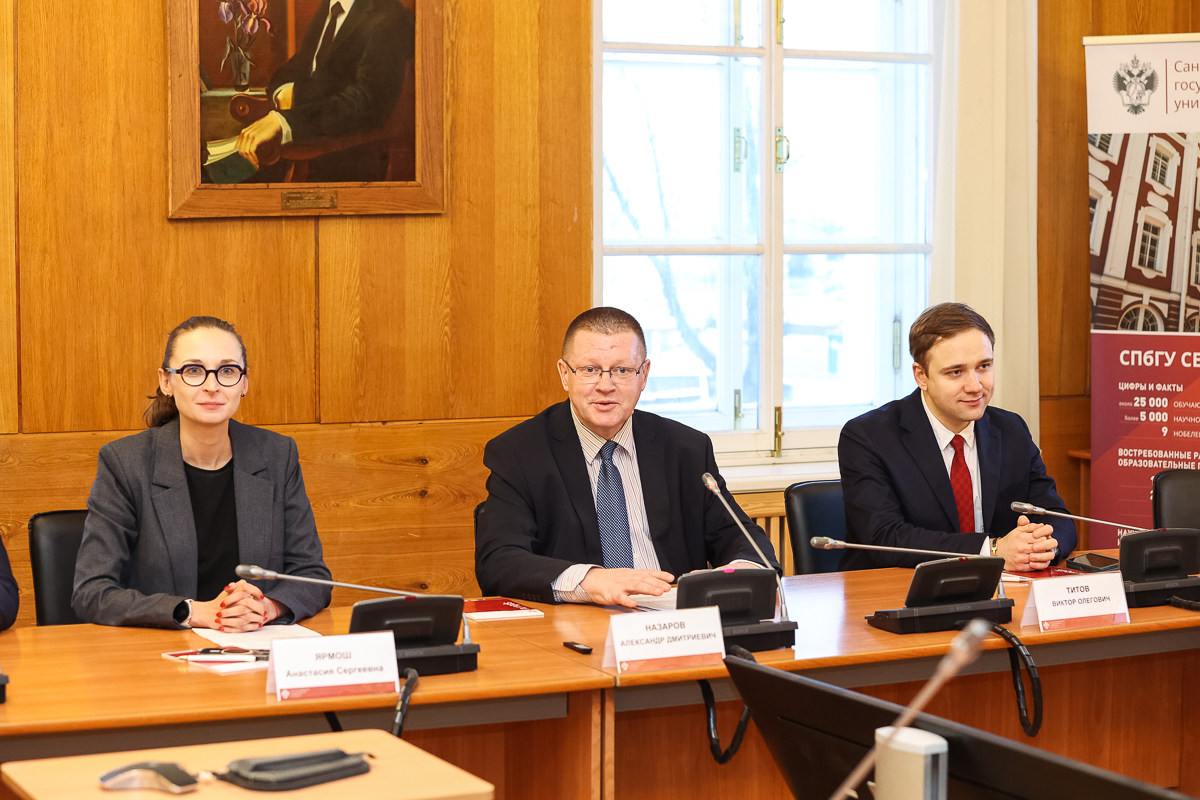Transport reform discussed at St Petersburg University
The University has hosted a round table discussion devoted to the transport reform in St Petersburg. During the discussion, representatives of the scientific and expert community and government authorities considered the prerequisites and socio-economic consequences of the reform. They also discussed the related legal problems and ways to solve them.
The round table on the transport reform was a follow-up of a large-scale discussion that had taken place in February at St Petersburg University, said Anastasia Yarmosh, Vice-Rector for Strategic Development and Partnership at St Petersburg University. Municipal reforms in general were a discussion point then. The experts considered problems in the housing and community amenities sector, transport, and construction. They discussed their possible solutions and further prospects. The next step was an appeal of the University’s partners interested in the development of transport reform.
We received quite a lot of interesting materials to work with. Using a versatile approach that has always been a hallmark of St Petersburg University, our scholars with an expertise in law, sociology, and economics considered the transport reform from a historical perspective. By looking back and studying individual factors, we were able to look ahead.
Anastasia Yarmosh, Vice-Rector for Strategic Development and Partnership at St Petersburg University
’Today, the material that has already been prepared for several months will be presented to the expert urban community of St Petersburg. We hope that the work done during the year will be continued and such expert sessions will help implement systemically important reforms in the city. Each next step that we take is of concern to each of us, and St Petersburg University can make its contribution to it,’ said Anastasia Yarmosh.

The round table discussion was moderated by Aleksandr Nazarov, Director of the University Centre of Expert Advice. St Petersburg University has already been engaged in expert activities for ten years. Each year, it issues about 2,000 interdisciplinary expert opinions covering a huge variety of areas.
Research in the field of urban studies proves that efficient public transport in the city is one of the key links in a comfortable urban environment. The historically complex configuration of the road network of St Petersburg, the lag in its development from the pace of motorisation and urban development of new territories, as well as the low pedestrian accessibility of the fastest transport, the St Petersburg Metro, demonstrated that the need for reform in the city had long been overdue. The economists of St Petersburg University Elena Efimova, Professor in the Department of World Economy, and Vitaly Kovalev, Professor in the Department of Credit Theory and Financial Management, spoke about its socio-economic consequences.
According to the new transport service model, 462 social bus routes operate in St Petersburg today. They include 99 new ones. 347 routes are served by commercial carriers under gross contracts, another 115 — by "Passazhiravtotrans".
Alongside with the creation of new routes, the purchase of new buses has begun. In total, since the beginning of 2022, more than 3,000 vehicles have been purchased in St Petersburg. It is the largest renewal of the city’s transportation fleet ever. St Petersburg University experts emphasised that, for successful implementation of the reform, that process had to be an ongoing one. The reason is that buses that have been in operation for 20 years or more will look completely unattractive.

One of the significant aspects of the transport reform is the improvement of logistics, which made it possible to increase the accessibility of remote areas for citizens. ’Certainly, changing the road transport pattern requires an adaptation of city residents who have to change their habitual behaviour. But this does not take much time,’ explained Professor Kovalev. ’If you scope out the big picture, you will see that the improvement of urban road transport routes and the development of new traffic systems have reduced the average travel time and help more effectively control compliance with the schedule. This has made transport more accessible and more convenient for the citizens of St Petersburg.’
Other benefits of the reform include the improved public transport safety. It was facilitated by: the transition to a unified road transport system; and remuneration of drivers according to the number of trips and not of the passengers transported. From July to October 2022, the total number of traffic collisions in St Petersburg decreased by 20%, the number of accidents caused by buses decreased by 30%, and the number of persons injured or killed decreased by 12%.
As of today, the strategic goals for the development of urban transport have been achieved by 40-50%.
At the same time, the city faces certain difficulties in implementing the reforms. In particular, not all of the buses arrive on time and receive appropriate maintenance. And due to digitisation, it is impossible to pay your fare in cash in some buses. As of today, the bus fleet is prevailing, while trams and trolleybuses remain uninvolved because the implementation of these projects is even longer in time. At the same time, the perception of the transport reform by the citizens is characterised by its assessment as a whole. Our citizens do not single out any shortcomings or failures in the development of individual links. They perceive failure in a complex way, as the inability of the city to cope with the implementation of the goals set.
’From an economist’s point of view, assessing the effectiveness of the transport reform is an assessment of a complex system in which a number of quantitative and qualitative parameters can be distinguished. Each of them has its own weight in the eventual outcome,’ Professor Efimova noted. ’St Petersburg University experts analysed the results of the transport reform in St Petersburg and identified six key parameters. They are: safety; convenience of the route network; renewal of the fleet; ease of payment and comfortable rates; the state of information services; and road transport inclusion. Each of them was evaluated on a five-point scale. That helped the expert economists at St Petersburg University rate the results of the city’s transport reform at 99 points out of 120.’
According to Professor Efimova, this result shows that the level of implementation of the reform is much higher than the average, but still there are certain growth points where it is possible to achieve better results in the near future. That requires constant monitoring of the system and timely fixing of changes.

Dmitrii Petrov, Professor in the Department of Commercial Law of St Petersburg University, addressed the legal side of the problem of cash acceptance refusal. In 2022, buses will be phased out from accepting cash directly on board. It will be possible to pay your fare using: the "Podorozhnik" card; a low fare e-ticket; a bank card; or a single QR ticket. However, according to the lawyer, banknotes and coins of the Bank of Russia are the only legal means of cash payment in the Russian Federation. They are required to be accepted at face value when making all types of payments.
And what about the citizens who have been declared bankrupt and undergo the procedure of debtor’s assets disposal? They receive money for living in cash, and their accounts are managed by financial managers.
Dmitrii Petrov, Professor in the Department of Commercial Law, St Petersburg University
At the same time, the Rules for the Carriage of Passengers and Baggage by Motor Transport and Electric Urban Road Transport provide for paying and refunding fares both in cash and non-cash forms.
Pavel Adarich, Deputy Director for Transport Management of the St Petersburg State Public Institution "Transportation Organiser", spoke about the history of the development of a new model of transport service. He said that the planning of the transport reform began in 2018. Five options for the route network reorganisation were considered. The experts took into account the following factors: the volume of passenger traffic; transfer ratio; the average travel time; and the degree of route duplication by various modes of transport. As a result, the most balanced option in terms of all key indicators was chosen from the suggested ones.
The transition to a new model of transport service is part of a large transport reform in St Petersburg. First of all, it is a social project.
Pavel Adarich, Deputy Director for Transport Management, St Petersburg State Public Institution "Transportation Organiser"
’Currently, all types of benefits are available on all public transport in the city. It is important for pensioners, students, schoolchildren and other categories who were not eligible for reduced fares when using commercial fixed-route buses. Almost 40% of passengers enjoy certain benefits, so it was important for us to ensure that they can freely use the entire route network of St Petersburg,’ said Pavel Adarich. ’At the same time, only 20% of the total volume of the city’s route network was reformed. Most passengers did not have to change their transport behaviour. Let me emphasise that the transfer ratio increased by only 0.02, while the average travel time decreased by almost 1.5 minutes. In April 2022, a new "60 Minutes" transfer rate was introduced in St Petersburg. It allows you to pay 10 roubles for your first transfer while all subsequent transfers within an hour are absolutely free.’
According to the speaker, the selected transport service model is the best starting point. Having started, we need to continue optimisation. For example, during the planning of this model, more than 100 apartment buildings were put into operation in the city. That is why, taking into account the changes already made, the 2022 route network differs from the one planned in 2018. The work on the constant optimisation and development of the mass road transport network is ongoing.







